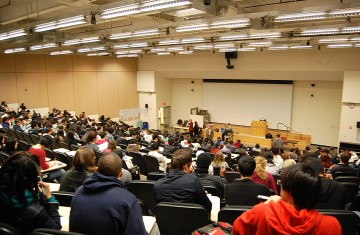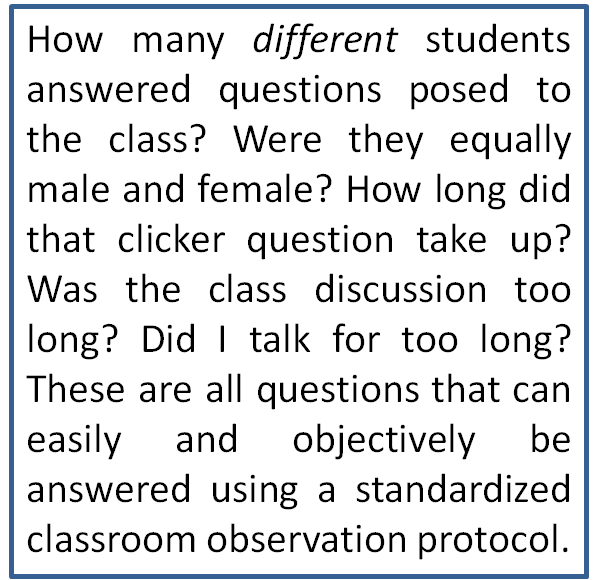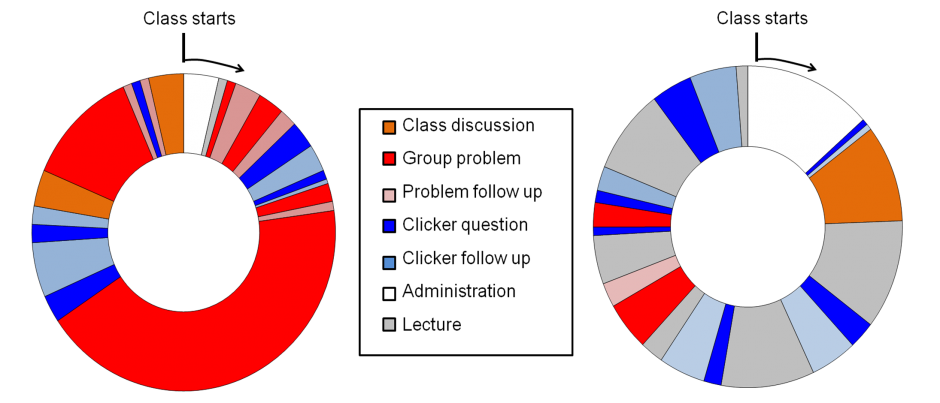Have you ever wondered what you look like to the audience while giving a presentation? You know how you are feeling and what you think you are doing, but is it the same as what others perceive? The same kind of question can be asked of teaching: while teaching, am I actually doing what I think I am doing? In this post we discuss how you can objectively characterize your classroom practice.

The effects of being in the spotlight can influence our perceptions of classroom practice. (Image: Wikipedia)
The emotional impact of being in front of an audience can sometimes skew our sense of perception. For example, an acceptable pause to wait for student questions can feel like an uncomfortable eternity when standing up at the front (complete with chirping crickets). The importance of silence is often underestimated, especially when posing questions in class. How long do you wait for a student response? How long do you wait when you ask whether anyone has any questions? Our  answer to this is often ‘forever!’ Frequently, however, even though we wait for what seems like an adequate period of time, students are still formulating their responses or working up the courage to speak up during class. Usually a pause that, in reality, is only a couple of seconds (the apparent eternity to us) is far too short for students to respond, leaving them with the impression that we rush on, and us with the impression that the students are reluctant to talk.
answer to this is often ‘forever!’ Frequently, however, even though we wait for what seems like an adequate period of time, students are still formulating their responses or working up the courage to speak up during class. Usually a pause that, in reality, is only a couple of seconds (the apparent eternity to us) is far too short for students to respond, leaving them with the impression that we rush on, and us with the impression that the students are reluctant to talk.
How can you find out what’s really happening in your classroom?
You can find out about your teaching by having your practices observed using the Classroom Observation Protocol for Undergraduate STEM (Science, technology, engineering and mathematics), or COPUS (Smith et al, 2013). COPUS is a validated protocol that allows a trained observer to objectively characterize classroom activity. Every two minutes, the observer notes down different activities occurring in class at that moment, both what the students are doing and what the instructor is doing. Observations can also incorporate a measure of student engagement (e.g. what fraction of students observed are obviously engaged in the class versus obviously disengaged).
 What can COPUS data tell us? COPUS observations take an objective a snapshot of how much class time is allocated to different activities. Useful charts, such as those below, allow us to see how much of our class time is spent on a particular activity, as well as how the different tasks are distributed throughout the lesson. COPUS data can facilitate awareness of classroom practices and can help to inform (as well as document) changes that occur in these practices. For example, you may be trying to add more active learning to your class (as recently discussed here ). COPUS data can help you measure the changes you are making and provide an opportunity for feedback on your practice. This kind of data could also be included in tenure portfolios to demonstrate deliberate practice.
What can COPUS data tell us? COPUS observations take an objective a snapshot of how much class time is allocated to different activities. Useful charts, such as those below, allow us to see how much of our class time is spent on a particular activity, as well as how the different tasks are distributed throughout the lesson. COPUS data can facilitate awareness of classroom practices and can help to inform (as well as document) changes that occur in these practices. For example, you may be trying to add more active learning to your class (as recently discussed here ). COPUS data can help you measure the changes you are making and provide an opportunity for feedback on your practice. This kind of data could also be included in tenure portfolios to demonstrate deliberate practice.
Interested in having your class observed? We would be happy to visit your class and provide a COPUS observation, and follow-up with a discussion about the observation. Observations can be all-encompassing (what does my classroom look like?) or tailored to focus on a particular aspect of teaching (e.g. how much time do I spend providing feedback after a group activity?). Observations can be a one-off event, or can track practice over time with multiple observations. For example, you may be planning to implement a new teaching strategy and wish to document your progress. Whatever the case, please feel free to contact us for assistance.
What have we been doing in your classrooms?
This academic year, the Life Science Teaching and Learning Fellows (LS-STLFs) are conducting research into the culture of classroom practice at UBC. So far, in the fall term, we have carried out a week’s worth of COPUS observations across 9 courses with the aim of characterising what undergraduate classrooms look like here in UBC Biology. Observations will continue in more courses over the winter term. We are administering pre- and post course diagnostic surveys and hope to make some general conclusions regarding classroom activity and student learning.
References:
Smith, M. K., Jones, F. H. M., Gilbert, S. L. & Wieman, C. E. (2013). The Classroom Observation Protocol for Undergraduate STEM (COPUS): A new instrument to characterize university STEM classroom practices. CBE-Life Sciences Education, 12 (4), 618-627.

